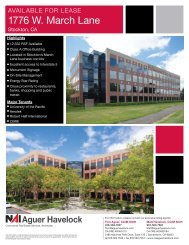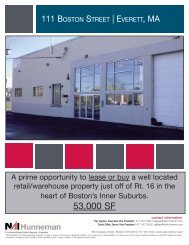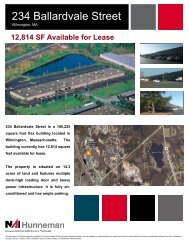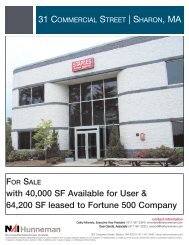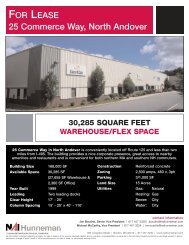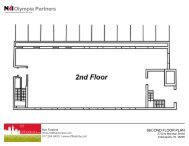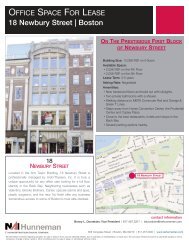2012 Global Market report - NAI Global
2012 Global Market report - NAI Global
2012 Global Market report - NAI Global
Create successful ePaper yourself
Turn your PDF publications into a flip-book with our unique Google optimized e-Paper software.
<strong>Global</strong> Outlook<br />
US Year in Review<br />
As 2011 comes to a close, commercial real estate markets across<br />
the United States are continuing to struggle as high unemployment,<br />
deficit and debt crises in the United States and Europe, and political<br />
gridlock in Washington have heightened concerns about the strength<br />
of the economic recovery and created a highly uncertain business<br />
environment. While there was positive momentum and strong leasing<br />
activity in most markets for the first half of 2011, market fundamentals<br />
stagnated in the second half as the uncertain economic climate<br />
weighed on demand. Vacancy rates remain high but have declined<br />
in many markets, though most of the improvement took place in the<br />
first half of the year. Asking rents also remain low, though there have<br />
been improvements in some markets.<br />
Office occupiers are taking advantage of low rental rates to upgrade<br />
to Class A office properties in central business districts. However, while<br />
leasing activity has been strong, many organizations are consolidating<br />
operations by embracing efficient space design and reducing their<br />
office footprint, resulting in negative absorption. Vacancy rates for CBD<br />
Class A office increased by 4% to 13.8% in 2011. National average<br />
asking rents slipped from $32.51 in 2010 to $29.59 in 2011.<br />
The proverbial flight to quality is also taking place in suburban office<br />
markets, with the national vacancy rate for Class A suburban office<br />
declining 2.6% to 16.6%, as tenants upgrade from Class B and C<br />
properties. High vacancy rates continue to place downward pressure<br />
on rents, with the national average asking rent declining by 6.4% to<br />
$23.03.<br />
Office markets will continue to be weighed down by slow economic<br />
growth and uncertainty from the global financial crisis. Improvement<br />
is unlikely until there is sustainable employment growth and a more<br />
certain business climate. However, with record corporate profits and<br />
limited new construction, market conditions will tighten rapidly with<br />
economic growth, as many organizations will have to expand to<br />
accommodate new employees.<br />
Retail markets improved slightly, though many retail centers continue<br />
to cope with large big box vacancies. Many markets have had new<br />
entries with local retailers taking advantage of low rents to backfill<br />
vacancies left by national chains, especially in better locations. The<br />
power center vacancy rate declined to 8.7%, a 6.5% decrease from<br />
2011, while average asking rents declined by 5.1% to $17.58. The CBD<br />
retail vacancy rate declined to 7.4%, a 10.1% decrease from 2010 with<br />
CBD retail average asking rents declining by $6.77 to $33.02.<br />
Industrial markets across the country are increasingly bifurcated, with<br />
strong demand for well-located Class A industrial properties and little<br />
demand for outmoded Class B and C properties. With limited new<br />
construction, vacancy rates for bulk warehouse space stabilized at<br />
10.6%, a modest 10 basis-point decrease from 2011. Bulk warehouse<br />
rents weakened by $.041 to $4.14. However, much of the decline in<br />
asking rents reflects the low rents of subpar Class B and C properties.<br />
United States capital markets soared in 2011. According to Real<br />
Capital Analytics, investment sales volume stood at $178.8 billion as<br />
of November 2011, easily surpassing the $116 billion mark set in<br />
2010. Cap rates continued to compress in virtually every market, with<br />
national average cap rates for all property types below 8%. Strong<br />
investment sales activity is likely to continue as historically low interest<br />
rates and high investor demand is driving fierce competition for<br />
assets, especially in core US markets.<br />
national average rental rates<br />
2006 2007 2008 2009 2010 2011<br />
Office<br />
Downtown-Class A $36.02 $41.93 $47.31 $37.11 $32.51 $29.59<br />
Suburban-Class A $24.49 $25.87 $26.32 $25.48 $25.45 $23.83<br />
Industrial<br />
Bulk Warehouse $4.66 $4.66 $4.63 $4.60 $4.55 $4.14<br />
Manufacturing $5.14 $5.57 $5.30 $4.89 $4.42 $4.41<br />
Hi-Tech/R&D $9.87 $10.03 $11.11 $8.56 $8.43 $6.69<br />
Retail<br />
Downtown Retail $47.70 $48.09 $51.28 $39.90 $39.79 $33.02<br />
Service Centers $20.56 $20.53 $18.55 $17.50 $16.48 $15.94<br />
Power Centers $22.33 $22.54 $20.77 $19.15 $18.53 $17.58<br />
Regional Malls $44.97 $46.26 $36.66 $32.27 $30.15 $26.07<br />
Source: <strong>NAI</strong> <strong>Global</strong><br />
national average rental rates<br />
2006 2007 2008 2009 2010 2011<br />
national average Vacancy rates<br />
2006 2007 2008 2009 2010 2011<br />
Office<br />
Downtown-Class A 9.9% 9.6% 10.3% 13.8% 13.3% 13.8%<br />
Suburban-Class A 13.2% 12.9% 13.0% 16.6% 17.1% 16.6%<br />
Industrial<br />
Bulk Warehouse 10.7% 9.1% 7.4% 10.9% 10.7% 10.6%<br />
Manufacturing 8.7% 7.6% 7.8% 10.9% 10.9% 11.6%<br />
Hi Tech/R&D 11.9% 11.4% 11.2% 12.3% 12.2% 10.6%<br />
Retail<br />
Downtown Retail 7.4% 6.6% 7.5% 8.9% 8.2% 7.4%<br />
Service Centers 7.8% 7.2% 8.4% 11.7% 12.7% 11.1%<br />
Power Centers 6.0% 5.3% 5.9% 9.9% 9.3% 8.7%<br />
Regional Malls 5.4% 4.8% 5.6% 7.0% 6.5% 7.8%<br />
Source: <strong>NAI</strong> <strong>Global</strong><br />
national average Vacancy rates<br />
2006 2007 2008 2009 2010 2011<br />
<strong>2012</strong> <strong>Global</strong> <strong>Market</strong> Report n www.naiglobal.com<br />
4



